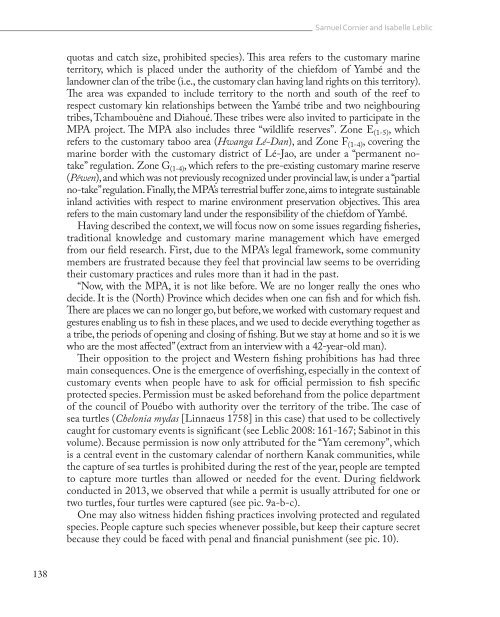Fisheries in the Pacific
Fisheries_in_the_Pacific
Fisheries_in_the_Pacific
Create successful ePaper yourself
Turn your PDF publications into a flip-book with our unique Google optimized e-Paper software.
Samuel Cornier and Isabelle Leblic<br />
quotas and catch size, prohibited species). This area refers to <strong>the</strong> customary mar<strong>in</strong>e<br />
territory, which is placed under <strong>the</strong> authority of <strong>the</strong> chiefdom of Yambé and <strong>the</strong><br />
landowner clan of <strong>the</strong> tribe (i.e., <strong>the</strong> customary clan hav<strong>in</strong>g land rights on this territory).<br />
The area was expanded to <strong>in</strong>clude territory to <strong>the</strong> north and south of <strong>the</strong> reef to<br />
respect customary k<strong>in</strong> relationships between <strong>the</strong> Yambé tribe and two neighbour<strong>in</strong>g<br />
tribes, Tchambouène and Diahoué. These tribes were also <strong>in</strong>vited to participate <strong>in</strong> <strong>the</strong><br />
MPA project. The MPA also <strong>in</strong>cludes three “wildlife reserves”. Zone E (1-5) , which<br />
refers to <strong>the</strong> customary taboo area (Hwanga Lé-Dan), and Zone F (1-4) , cover<strong>in</strong>g <strong>the</strong><br />
mar<strong>in</strong>e border with <strong>the</strong> customary district of Lé-Jao, are under a “permanent notake”<br />
regulation. Zone G (1-4) , which refers to <strong>the</strong> pre-exist<strong>in</strong>g customary mar<strong>in</strong>e reserve<br />
(Péwen), and which was not previously recognized under prov<strong>in</strong>cial law, is under a “partial<br />
no-take” regulation. F<strong>in</strong>ally, <strong>the</strong> MPA’s terrestrial buffer zone, aims to <strong>in</strong>tegrate susta<strong>in</strong>able<br />
<strong>in</strong>land activities with respect to mar<strong>in</strong>e environment preservation objectives. This area<br />
refers to <strong>the</strong> ma<strong>in</strong> customary land under <strong>the</strong> responsibility of <strong>the</strong> chiefdom of Yambé.<br />
Hav<strong>in</strong>g described <strong>the</strong> context, we will focus now on some issues regard<strong>in</strong>g fisheries,<br />
traditional knowledge and customary mar<strong>in</strong>e management which have emerged<br />
from our field research. First, due to <strong>the</strong> MPA’s legal framework, some community<br />
members are frustrated because <strong>the</strong>y feel that prov<strong>in</strong>cial law seems to be overrid<strong>in</strong>g<br />
<strong>the</strong>ir customary practices and rules more than it had <strong>in</strong> <strong>the</strong> past.<br />
“Now, with <strong>the</strong> MPA, it is not like before. We are no longer really <strong>the</strong> ones who<br />
decide. It is <strong>the</strong> (North) Prov<strong>in</strong>ce which decides when one can fish and for which fish.<br />
There are places we can no longer go, but before, we worked with customary request and<br />
gestures enabl<strong>in</strong>g us to fish <strong>in</strong> <strong>the</strong>se places, and we used to decide everyth<strong>in</strong>g toge<strong>the</strong>r as<br />
a tribe, <strong>the</strong> periods of open<strong>in</strong>g and clos<strong>in</strong>g of fish<strong>in</strong>g. But we stay at home and so it is we<br />
who are <strong>the</strong> most affected” (extract from an <strong>in</strong>terview with a 42-year-old man).<br />
Their opposition to <strong>the</strong> project and Western fish<strong>in</strong>g prohibitions has had three<br />
ma<strong>in</strong> consequences. One is <strong>the</strong> emergence of overfish<strong>in</strong>g, especially <strong>in</strong> <strong>the</strong> context of<br />
customary events when people have to ask for official permission to fish specific<br />
protected species. Permission must be asked beforehand from <strong>the</strong> police department<br />
of <strong>the</strong> council of Pouébo with authority over <strong>the</strong> territory of <strong>the</strong> tribe. The case of<br />
sea turtles (Chelonia mydas [L<strong>in</strong>naeus 1758] <strong>in</strong> this case) that used to be collectively<br />
caught for customary events is significant (see Leblic 2008: 161-167; Sab<strong>in</strong>ot <strong>in</strong> this<br />
volume). Because permission is now only attributed for <strong>the</strong> “Yam ceremony”, which<br />
is a central event <strong>in</strong> <strong>the</strong> customary calendar of nor<strong>the</strong>rn Kanak communities, while<br />
<strong>the</strong> capture of sea turtles is prohibited dur<strong>in</strong>g <strong>the</strong> rest of <strong>the</strong> year, people are tempted<br />
to capture more turtles than allowed or needed for <strong>the</strong> event. Dur<strong>in</strong>g fieldwork<br />
conducted <strong>in</strong> 2013, we observed that while a permit is usually attributed for one or<br />
two turtles, four turtles were captured (see pic. 9a-b-c).<br />
One may also witness hidden fish<strong>in</strong>g practices <strong>in</strong>volv<strong>in</strong>g protected and regulated<br />
species. People capture such species whenever possible, but keep <strong>the</strong>ir capture secret<br />
because <strong>the</strong>y could be faced with penal and f<strong>in</strong>ancial punishment (see pic. 10).<br />
138


